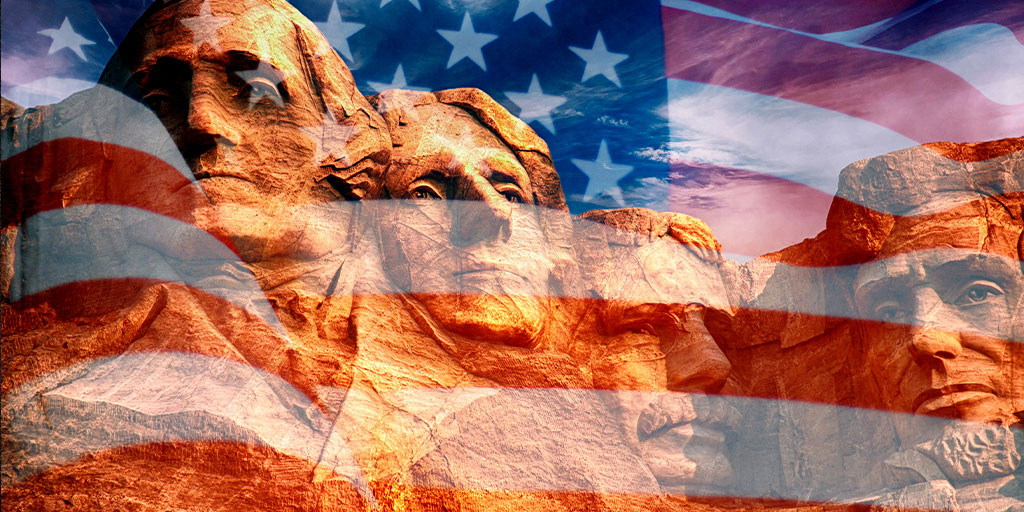The President of the United States is generally considered the most powerful person on the planet. It’s been so since World War II. These days, the American Presidency gets more publicity than pretty much anything else. It hasn’t always been the case. But our nation’s history is full of great leaders and some eccentric characters. Knowing how controversial and divisive the subject has become, I thought I would spend this week covering a little history of the American Presidency, ahead of the President’s Day holiday weekend.
It all started with our first President. George Washington is the only President to receive a unanimous vote. He won every state in 1789. There were 15 back then. Washington’s Vice President was John Adams. His first Secretary of State was John Jay. After just a year, Jay was replaced by Thomas Jefferson, who, of course, became our nation’s 3rd President, after Adams. Alexander Hamilton was Washington’s Treasury Secretary. Jefferson and Hamilton did not get along. Our first President was inaugurated at Federal Hall in New York City, across the street from the New York Stock Exchange. George Washington’s Presidential House was in Philadelphia, but he selected a swamp area near Virginia to become the nation’s capital, which bears his name. Every President since John Adams occupied the office in Washington DC. Previously called the Executive Mansion and President’s Palace, Theodore Roosevelt officially gave the White House its name in 1901, a century after it was built.
President’s Day first became a holiday in 1879 to honor Washington’s birthday (February 22, 1732). George Washington died just 17 days before the turn of the century and just two years after he left office. He was 67 years old. Americans unofficially began celebrating Washington’s birthday in 1800, the year after his passing. Washington’s birthday became a Federal holiday in 1885. In 1971 it was switched to the 3rd Monday in February. Since Abraham Lincoln’s birthday is in close proximity, the holiday became President’s Day sometime in the 1980s.
George Washington did not want to serve a second term. Neither did his wife, Martha. It has been reported that he grew tired of infighting within his own cabinet and politics in general. Imagine that! But the young nation was seemingly not ready for him to leave office after his first four years. He was the Great American Hero. So Washington continued on for another four years. In 1796, Washington declined to run for a third term in office, believing that extending his role would create an image of a lifetime appointment. The precedent of a two-term limit was created by Washington’s retirement. Franklin Delano Roosevelt sought and was elected to a third term, breaking Washington’s two-term precedent. It happened again four years later, with the U.S. engaged in World War II. FDR died 82 days into his fourth term in 1945 and was replaced by Harry S. Truman.
Thomas Jefferson purchased the Louisiana Territory from the French in 1803, which expanded America’s reach west.
Abraham Lincoln was self-educated and grew up in poverty in the American frontier. Lincoln emancipated the slaves, gave the most famous Presidential speech in his Gettysburg Address, and saved the Union after going through the most dangerous and divisive period in our nation’s history, the Civil War.
John F. Kennedy was the youngest President to be elected. He was 43 years old. However, Teddy Roosevelt was the youngest President to enter the office. He succeeded William McKinley after he was assassinated in 1901, and served two terms, though elected once. Teddy attempted a failed 3rd term. Ronald Reagan was the oldest elected President at age 73.
Teddy Roosevelt was a trustbuster, going after the American monopolies, which were Standard Oil, Carnegie Steel and Vanderbilt’s Railroads. Roosevelt pushed for the Panama Canal. Teddy also saved a bear (which drew the name Teddy Bear) and was instrumental in establishing the national parks, conserving Yellowstone and Yosemite, among others.
Abraham Lincoln was the tallest President, standing 6 feet, 4 inches. James Madison was the shortest President at 5 feet, 4 inches.
There have been three Presidents impeached: Andrew Johnson, Bill Clinton and Donald Trump. Richard Nixon resigned before impeachment.
Four Presidents were assassinated. Abraham Lincoln was killed at Ford’s Theater by John Wilkes Boothe in 1865. Others were James A. Garfield (1881), William McKinley (1901), and of course John F. Kennedy in Dallas in 1963. Teddy Roosevelt and Ronald Reagan had assassination attempts and survived. Both were at speeches. Reagan was headed to his car and said he forgot to duck. Teddy Roosevelt actually finished his speech with a bullet wound in his chest before going to the hospital for treatment.
Four of our Presidents are on Mt. Rushmore in South Dakota. George Washington, Thomas Jefferson, Abraham Lincoln and Teddy Roosevelt. It was completed in 1941.
Both John Adams and Thomas Jefferson died on the same day, July 4th, 1826. This was also the 50th anniversary of the Declaration of Independence, the document that Jefferson both wrote and signed. That’s pretty remarkable.
We are an imperfect union. Admitting it is perhaps our greatest strength. It takes courage to acknowledge weakness and work to improve with tenacity. It can be an ugly process. It feels that way now. Politics are emotional. They’re messy. They bring out the best and the worst in people. November will bring another heated election. That’s nothing new. We keep moving forward.
Hopefully, this piece brought peace of mind to the history of our Presidency. The Market is paying attention. So are we.
Have a nice weekend. We’ll be back, dark and early on Tuesday. The Market will be closed on Monday, as will our office, in honor of George Washington and Abe Lincoln’s birthdays.
Mike







